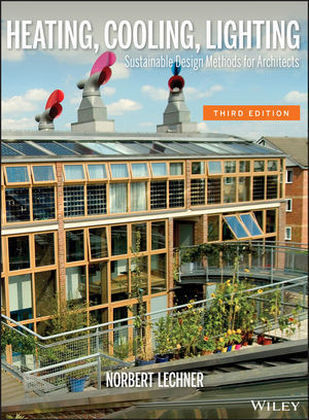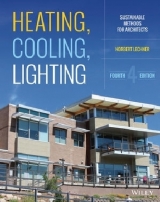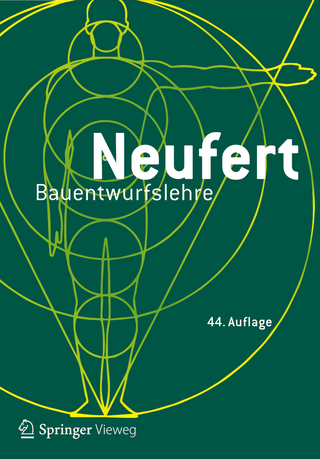
Heating, Cooling, Lighting
John Wiley & Sons Ltd (Verlag)
978-0-470-04809-2 (ISBN)
- Titel erscheint in neuer Auflage
- Artikel merken
One of the leading references on the design of a building's environmental controls has just gotten better. For years, Heating, Cooling, Lighting has supplied architects and students with the strategies needed for initial design decisions for building systems. The book looks at how to design the form of the building itself to take advantage of natural heating, cooling, and lighting and how to best utilize active mechanical equipment to satisfy the needs not provided by nature. This new edition has been expanded and updated to reflect the latest codes, standards, and energy-efficiency rating systems.
Norbert Lechner is Professor Emeritus in the College of Architecture, Design, and Construction at Auburn University and was a registered architect in the state of Alabama. His articles have appeared in Architectural Lighting and Solar Today . In addition to writing, he has lectured and held workshops in the United States, Europe, Asia, and the Middle East.
Foreword to the First Edition. Foreword to the Third Edition. Preface. Acknowledgments. 1. HEATING, COOLING, AND LIGHTING AS FORM-GIVERS IN ARCHITECTURE. 1.1 Introduction. 1.2 Vernacular and Regional Architecture. 1.3 Formal Architecture. 1.4 The Architectural Approach. 1.5 Dynamic versus Static Buildings. 1.6 Passive Survivability. 1.7 Energy and Architecture. 1.8 Architecture and Heating, Cooling, and Lightning. 1.9 Conclusion. 2. SUSTAINABLE DESIGN. 2.1 Easter Island: Learning from the Past. 2.2 Sustainable Design. 2.3 Reuse, Recycle, and Regenerate by Design. 2.4 The Green Movement. 2.5 Population and Sustainability. 2.6 Growth. 2.7 Exponential Growth. 2.8 The Amoeba Analogy. 2.9 Supply versus Efficiency. 2.10 Sustainable-Design Issues. 2.11 Climate Change. 2.12 The Global Greenhouse. 2.13 The Ozone Hole. 2.14 Efficiency. 2.15 Energy Sources. 2.16 Ancient Greece: A Historical Example. 2.17 Nonrenewable Energy Sources. 2.18 Renewable Energy Sources. 2.19 Hydrogen. 2.20 Conclusion. 3. BASIC PRINCIPLES. 3.1 Introduction. 3.2 Heat. 3.3 Sensible Heat. 3.4 Latent Heat. 3.5 Evaporative Cooling. 3.6 Convection. 3.7 Transport. 3.8 Energy-Transfer Mediums. 3.9 Radiation. 3.10 Greenhouse Effect. 3.11 Equilibrium Temperature of a Surface. 3.12 Mean Radiant Temperature. 3.13 Heat Flow. 3.14 Heat Sink. 3.15 Heat Capacity. 3.16 Thermal Resistance. 3.17 Heat-Flow Coefficient. 3.18 Time Lag. 3.19 Insulating Effect of Mass. 3.20 Energy Conversion. 3.21 Combined Heat and Power. 3.22 Fuel Cells. 3.23 Embodied Energy. 3.24 Conclusion. 4. THERMAL COMFORT. 4.1 Biological Machine. 4.2 Thermal Barriers. 4.3 Metabolic Rate. 4.4 Thermal Conditions of the Environment. 4.5 The Psychometric chart. 4.6 Dew Point and Wet-Bulb Temperatures. 4.7 Heat Content of Air. 4.8 Thermal Comfort. 4.9 Shifting of the Comfort Zone. 4.10 Clothing and Comfort. 4.11 Strategies. 4.12 Conclusion. 5. CLIMATE. 5.1 Introduction. 5.2 Climate. 5.3 Microclimate. 5.4 Climatic Anomalies. 5.5 Climate Regions of the United States. 5.6 Explanations of the Climatic Data Tables. 5.7 Additional Climate Information. 5.8 Climate Information for Other Countries. Climate Data Tables. 5.9 Design Strategies. 6. SOLAR GEOMETRY. 6.1 Introduction. 6.2 The Sun. 6.3 Elliptical Orbit. 6.4 Tilt of the Eartha s Axis. 6.5 Consequences of the Altitude Angle. 6.6 Winter. 6.7 The Sun Revolves Around the Earth! 6.8 Sky Dome. 6.9 Determining Altitude and Azimuth Angles. 6.10 Solar Time. 6.11 Horizontal Sun-Path Diagrams. 6.12 Vertical Sun-Path Diagrams. 6.13 Sun-Path Models. 6.14 Solar Site-Evaluation Tools. 6.15 Heliodons. 6.16 Sundials for Model Testing. 6.17 Conceptually Clear Heliodons. 6.18 Conclusion. 7. PASSIVE SOLAR. 7.1 History. 7.2 Solar in America. 7.3 Solar Hemicycle. 7.4 Latest Rediscovery of Passive Solar. 7.5 Passive Solar. 7.6 Direct-Gain Systems. 7.7 Design Guidelines for Direct-Gain Systems. 7.8 Example. 7.9 Trombe Wall Systems. 7.10 Design Guidelines for Trombe Wall Systems. 7.11 Examples. 7.12 Suspaces. 7.13 Balcomb House. 7.14 Sunspace Design Guidelines. 7.15 Comparison of the Three Main Passive Heating Systems. 7.16 General Considerations for Passive Solar Systems. 7.17 Heat-Storage Materials. 7.18 Other Passive Heating Systems. 7.19 Conclusion. 8. PHOTOVOLTAICS AND ACTIVE SOLAR. 8.1 Introduction. 8.2 The Almost Ideal Energy Source. 8.3 History of PV. 8.4 The PV Cell. 8.5 Types of PV Systems. 8.6 Balance of System Equipment. 8.7 Building-Integrated Photovoltaics. 8.8 Orientation and Tilt. 8.9 Roofs Clad with PV. 8.10 Facades Clad with PV. 8.11 Glazing and PV. 8.12 PV Shading Devices. 8.13 PV: Part of the Second Tier. 8.14 Sizing a PV System. 8.15 Finding the PV Array Size for a Stand-Alone Building by the Short Calculation Method. 8.16 Design Guidelines. 8.17 The Promise of PV. 8.18 The Cost Effectiveness of PV and Active Solar Applications. 8.19 Active Solar Swimming-Pool Heating. 8.20 Solar Hot-Water Systems. 8.21 Solar Hot-Air Collectors. 8.22 Designing an Active Solar System. 8.23 Active/Passive Solar Systems. 8.24 Preheating of Ventilation Air. 8.25 The Future of Active Solar. 8.26 Conclusion. 9. SHADING AND LIGHT COLORS. 9.1 History of Shading. 9.2 Shading. 9.3 Fixed Exterior Shading Devices. 9.4 Movable Shading Devices. 9.5 Shading Periods of the Year. 9.6 Horizontal Overhangs. 9.7 Design of Horizontal Overhangsa Basic Method. 9.8 Shading Design for South Windows. 9.9 Design Guidelines for Fixed South Overhangs. 9.10 Design Guidelines for Movable South Overhangs. 9.11 Shading for East and West Windows. 9.12 Design of East and West Horizontal Overhangs. 9.13 Design of Slanted Vertical Fins. 9.14 Design of Fins on North Windows. 9.15 Design Guidelines for Eggcrate Shading Devices. 9.16 Special Shading Strategies. 9.17 Shading Outdoor Spaces. 9.18 Using Physical Models for Shading Design. 9.19 Glazing as the Shading Element. 9.20 Interior Shading Devices. 9.21 Shading Coefficient and Solar Heat-Gain Coefficient. 9.22 Reflection from Roofs and Walls. 9.23 Conclusion. 10. PASSIVE COOLING. 10.1 Introduction to Cooling. 10.2 Historical and Indigenous Use of Passive Cooling. 10.3 Passive Cooling Systems. 10.4 Comfort Ventilation versus Night-Flush Cooling. 10.5 Basic Principles of Air Flow. 10.6 Air Flow Through Buildings. 10.7 Example of Ventilation Design. 10.8 Comfort Ventilation. 10.9 Night-Flush Cooling. 10.10 Smart Facades and Roofs. 10.11 Radiant Cooling. 10.12 Evaporative Cooling. 10.13 Cool Towers. 10.14 Earth Cooling. 10.15 Dehumidification with a Desiccant. 10.16 Conclusion. 11. SITE DESIGN, COMMUNITY PLANNING, AND LANDSCAPING. 11.1 Introduction. 11.2 Site Selection. 11.3 Solar Access. 11.4 Shadow Patterns. 11.5 Site Planning. 11.6 Solar Zoning. 11.7 Physical Models. 11.8 Wind and Site Design. 11.9 Plants and Vegetation. 11.10 Green Roofs. 11.11 Lawns. 11.12 Landscaping. 11.13 Community Design. 11.14 Cooling Our Communities. 11.15 Conclusion. 12. LIGHTING. 12.1 Introduction. 12.2 Light. 12.3 Reflectance/Transmittance. 12.4 Color. 12.5 Vision. 12.6 Perception. 12.7 Performance of a Visual Task. 12.8 Characteristics of the Visual Task. 12.9 Illumination Level. 12.10 Brightness Ratios. 12.11 Glare. 12.12 Equivalent Spherical Illumination. 12.13 Activity Needs. 12.14 Biological Needs. 12.15 Light and Health. 12.16 The Poetry of Light. 12.17 Rules for Lighting Design. 12.18 Career Possibilities. 12.19 Conclusion. 13. DAYLIGHTING. 13.1 History of Daylighting. 13.2Why Daylighting? 13.3 The Nature of Daylight. 13.4 Conceptual Model. 13.5 Illumination and the Daylight Factor. 13.6 Light without Heat? 13.7 Cool Daylight. 13.8 Goals of Daylighting. 13.9 Basic Daylighting Strategies. 13.10 Basic Windows Strategies. 13.11 Advanced Windows Strategies. 13.12 Window Glazing Materials. 13.13 Top Lighting. 13.14 Skylight Strategies. 13.15 Clerestories, Monitors, and Light Scoops. 13.16 Special Daylighting Techniques. 13.17 Translucent Walls and Roofs. 13.18 Electric Lighting as a Supplement to Daylighting. 13.19 Physical Modeling. 13.20 Guidelines for Daylighting. 13.21 Conclusion. 14. ELECTRIC LIGHTING. 14.1 History of Light Sources. 14.2 Light Sources. 14.3 Incandescent and Halogen Lamps. 14.4 Discharge Lamps. 14.5 Fluorescent Lamps. 14.6 High Intensity Discharge Lamps (Mercury, Metal Halide, and High Pressure Sodium). 14.7 Comparison of the Major Lighting Sources. 14.8 Solid State Lighting. 14.9 Luminaires. 14.10 Lenses, Diffusers, and Baffles. 14.11 Lighting Systems. 14.12 Remote Source Lighting Systems. 14.13 Visualizing Light Distribution. 14.14 Architectural Lighting. 14.15 Outdoor Lighting. 14.16 Emergency Lighting. 14.17 Controls. 14.18 Maintenance. 14.19 Rules for Energy-Efficient Electric Lighting Design. 14.20 Conclusion. 15. THE THERMAL ENVELOPE: KEEPING WARM AND STAYING COOL. 15.1 Background. 15.2 Heat Loss. 15.3 Heat Gain. 15.4 Solar Reflectivity (Albedo). 15.5 Compactness, Exposed Area, and Thermal Planning. 15.6 Insulation Materials. 15.7 The Thermal Envelope. 15.8 Heat Bridges. 15.9 Windows. 15.10 Movable Insulation. 15.11 Insulating Effect from Thermal Mass. 15.12 Earth Sheltering. 15.13 Infiltration and Ventilation. 15.14 Moisture Control. 15.15 Radon. 15.16 Appliances. 15.17 Conclusion. 16. MECHANICAL EQUIPMENT FOR HEATING AND COOLING. 16.1 Introduction. 16.2 Heating. 16.3 Thermal Zones. 16.4 Heating Systems. 16.5 Electric Heating. 16.6 Hot-Water (Hydronic) Heating. 16.7 Hot-Air Systems. 16.8 Cooling. 16.9 Refrigeration Cycles. 16.10 Heat Pumps. 16.11 Geo-Exchange. 16.12 Cooling Systems. 16.13 Air Conditioning for Small Buildings. 16.14 Air Conditioning for Large Multistory Buildings. 16.15 Design Guidelines for Mechanical Systems. 16.16 Air Supply (Ducts and Diffusers). 16.17 Ventilation. 16.18 Energy-Efficient Ventilation Systems. 16.19 Air Filtration and Odor Removal. 16.20 Special Systems. 16.21 Integrated and Exposed Mechanical Equipment. 16.22 Conclusion. 17. CASE STUDIES. 17.1 Introduction. 17.2 The Real Goods Solar Living Center. 17.3 The Urban Villa. 17.4 The Emerald Peoplea s Utility District Headquarters. 17.5 Colorado Mountain College. 17.6 Gregory Bateson Building. 17.7 Commerzbank. 17.8 Phoenix Central Library. Appendix A: Horizontal Sun-Path Diagrams. Appendix B: Vertical Sun-Path Diagrams. Appendix C: Solar Altitude and Azimuth Angles. Appendix D: Methods for Estimating the Height of Trees, Buildings, etc. Appendix E: Sundials. Appendix F: Sun-Path Models. Appendix G: Computer Software Useful for the Schematic Design Stage. Appendix H: Site Evaluation Tools. Appendix I: Heliodons. Appendix J: Educational Opportunities in Energy-Conscious Design. Appendix K: Resources.
| Erscheint lt. Verlag | 12.12.2008 |
|---|---|
| Zusatzinfo | ill |
| Verlagsort | Chichester |
| Sprache | englisch |
| Maße | 218 x 279 mm |
| Gewicht | 1892 g |
| Einbandart | gebunden |
| Themenwelt | Technik ► Architektur |
| ISBN-10 | 0-470-04809-3 / 0470048093 |
| ISBN-13 | 978-0-470-04809-2 / 9780470048092 |
| Zustand | Neuware |
| Informationen gemäß Produktsicherheitsverordnung (GPSR) | |
| Haben Sie eine Frage zum Produkt? |
aus dem Bereich



